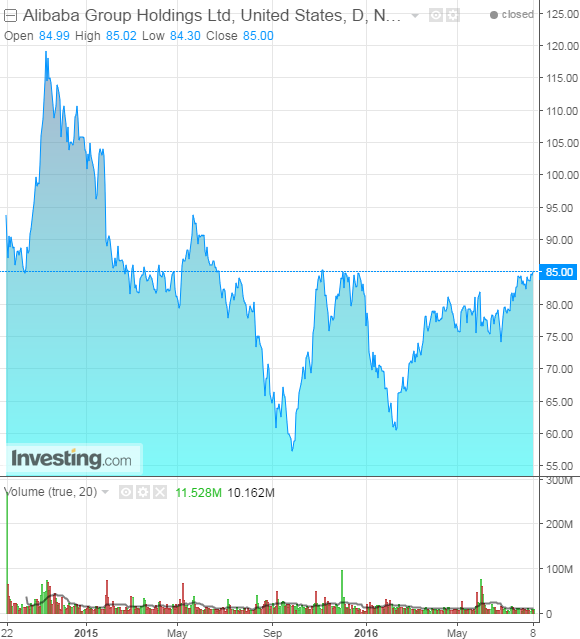by Clement Thibault
Alibaba Group Holdings Ltd (NYSE:BABA) , the China-based, international e-commerce retailer, reports Q1 '17 earnings on Thursday August 11, before the opening bell.

1. Earnings and Revenue forecast
Alibaba is expected to report earnings of $0.62 per share on $3.16 billion in revenue. For BABA to meet expectations, it would have to report YoY growth of a bit over 8% for EPS and a bit less than 4% for revenue. That's not very likely. During the past two quarters, Alibaba missed expectations, causing the stock price to drop. In response, on June 14th, Alibaba offered financial guidance for fiscal year 2017, starting with this quarter. The company said it expects revenue to grow by at least 48% for the full year, outpacing last year's 33% rate.
2. Commerce
Currently, Alibaba reaches 423 million annual, active buyers, most of them based in China. Though the company has international offerings, global commerce accounts for about 8% of Alibaba's top line revenue. Its core business right now is clearly retail in China, which accounts for 79% of its revenue.
2a. Gross Merchandise Volume
Gross merchandise volume (GMV), is the term used to indicate the total value of sales from a particular marketplace. This figure is important because it also can indicate the popularity and widespread recognition of a specific marketplace, allowing comparison between different marketplaces. For full fiscal 2016, which for BABA ended last quarter, Alibaba's GMV through its platforms Taobao—which is open to third-party sellers—and Tmall, which hosts official sellers only, reached $485 billion, compared to $382 billion the previous year. That's an increase of 27%.
That's an impressive number on its own, but compare that to last year's annual GMV increase of 46%. As Alibaba's marketplace grows bigger, its growth rate slows, which makes sense. Unfortunately Wall Street often forgets such salient facts. Quarterly the story is similar, with a 24% increase in GMV to $115 billion this quarter compared to a 40% increase in the same quarter last year. In comparison, Amazon's (NASDAQ:AMZN) GMV was about $225 billion for the entire 2015.
3. Revenue growth
As with GMV, revenues have been growing rather quickly, particularly for a company the size of Alibaba. For fiscal 2016, revenue grew 33%, to $15.6 billion compared to $12.3 billion in 2015. In 2015, the company clocked 45% growth, up from $8.9 billion. Alibaba's GMV/revenue ratio isn't stellar. It's 31, compared to Amazon's very low 2.1 for 2015. This is happening largely because some of Alibaba's platforms rely entirely on third party vendors, so profits come from fees collected upon customer payment through Alipay. Conversely, Amazon sells a greater percentage of its products directly, bringing more profit to the company without additional acquisition costs.
4. Domestic vs International
On its domestic front, Alibaba has plans to expand into rural China, bringing cities and villages closer together via an effective distribution chain. Alibaba is now a presence in over 14,000 rural villages, but with an estimated 900,000 rural villages in China nationwide, there's still quite a lot of runway for Alibaba. The company is also trying to tap into a previously inaccessible base of locations that were once considered too remote for e-commerce. Internationally, Alibaba recently acquired Singaporean e-retail platform Lazada which has a GMV of $1 billion. While that platform is still small, Alibaba intends on leveraging it to penetrate the e-commerce business in Southeast Asia.
5. Cloud Computing
Unquestionably, cloud computing is the buzzword of the year in the technology sector. Alibaba has its own cloud computing division, providing yet another point of comparison with Amazon. Amazon's cloud computing business is well ahead: Alibaba's cloud computing business generates $468 million in annual revenue, a number far lower than Amazon's operating income for a single quarter, which was $718 million in Q2. Still, Alibaba's cloud computing business is growing at a robust pace, with an annual growth rate of 138% in 2016, up from a little over $200 million in 2015. Alibaba might be late to the party on this, but the rapid growth in this still-burgeoning segment indicates there remains plenty of room at the table.
Conclusion
Overall, we see the outlook for Alibaba as positive. The company seems able to maintain its growth trends, and we expect it to continue acquiring smaller platforms throughout Asia in order to boost its international sales. Right now, Alibaba generates a lot of revenue by offering cheap (and often counterfeit) goods, something it has been criticized for and has tried to prevent. As the Chinese market matures, consumers will want higher-grade products and authentic merchandise. BABA's Tmall platform insures that it will not get left behind, even as consumer tastes evolve.
With additional acquisitions and escalating growth on the way, and because it is an already dominant player in still-emerging markets, Alibaba's current price of $85 a share suggests that investor expectations are not yet too high. We believe the company will get the opportunity to outshine expectations and should reward shareholders in the medium- to longer-term.
